2009 MXA 250 SHOOTOUT: A First-Time Win For Sales Leader, Lots Of Surprises & In Depth Analysis; All The Facts On How Each Bike Performs
As in any awards ceremony, there are winners and losers. The winners bask in all of the glory, deliver long-winded acceptance speeches, gear up for better sales, and carve a notch in their belt. The MXA wrecking crew has been testing the 2009 250 four-strokes for several months now. We’ve put in countless hours on the dyno, on the test track and in numerous races. We have run these bikes through the ringer and back again. We know all the positives and negatives; we’ve found fixes for nagging complaints, discovered the reasons for every major or minor production change, and have written a ream of test reports to back up our findings.
We are positive that we know which is the best 250cc four-stroke, but before we announce the winner, we feel obligated to share our rating of each bike based on categories we have deemed important. Please hold your applause until the end.
WHO MADE THE MOST CHANGES IN 2009?
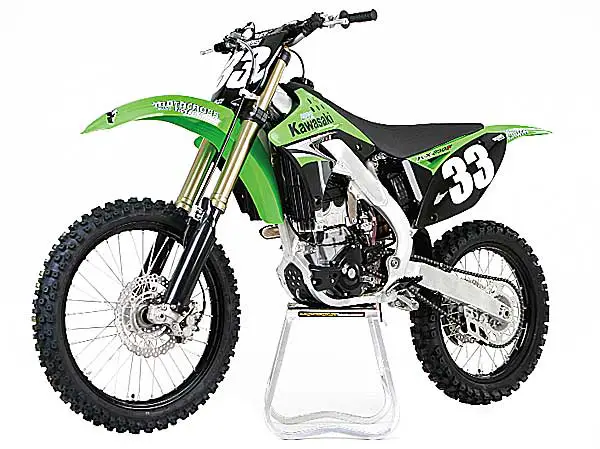
(1) Kawasaki. The Kawasaki marketing department was insistent on using the catchall phrase “all-new” when introducing the 2009 KX250F with good reason. Along with a new frame and subframe (which shaved 3.3 pounds), Kawasaki made major changes to the gearbox, swingarm and crankshaft. Numerous other changes were found in the suspension, engine, and overall aesthetics of the KX250F. While most of the other manufacturers warmed over their previous model year bikes, Kawasaki went for the gusto. The KX250F is far and away the most changed bike (on paper) for 2009.
(2) KTM. It’s not our intention to rub it in that the KTM 250SXF earned last place in MXA’s 2008 shootout, because in reality it was a pretty good motorcycle. It did, however, have serious flaws in the power delivery and suspension, which drastically lowered its overall ranking. Last year we spelled out the KTM’s issues in no uncertain terms, and the Austrians obviously paid close attention. For 2009, the KTM 250SXF received the second most changes of all the Big Five 250 four-strokes. Many of these changes focused on improving bottom-end power in the engine, smoothing out the damping, and dialing in the suspension.
(3) Yamaha. It may seem that the last time the YZ250F engine received any noticeable changes was when George Bush, the elder, was still in the White House. In many ways, Yamaha didn’t feel that their bike needed any help. It had been the dominant machine in the 250 four-stroke class for many years. (in fact, it invented the class). In 2009, Yamaha’s engineers finally decided that some remedial action was necessary. They stayed away from the internals on the engine and instead hammered out the kinks in the 2008 YZ250F chassis. The biggest change was the new hydroformed swingarm, which not only lightened up the bike, but also changed the flex and rigidity characteristics. Overall, the 2009 YZ250F received 17 changes.
(4) Honda. Earning the runner-up spot in MXA’s 2008 250 Shootout, the Honda CRF250F‘s faults were few but significant. In 2008, the forks were extremely harsh and the jetting sputtered more than Adam Sandler in “The Waterboy.” For 2009, Honda R&D’ed a few changes, but none that worked on the forks or the jetting. The biggest changes are a new exhaust system and some head mods.
(5) Suzuki. The 2009 Suzuki RM-Z250 didn’t receive changes. We take that back! The 2009 RM-Z250 is the exact same bike as the 2008 model, save for a yellow front number plate, new shroud graphics and updated seat cover.
WHO HAS THE BEST ALL-AROUND POWERBAND?
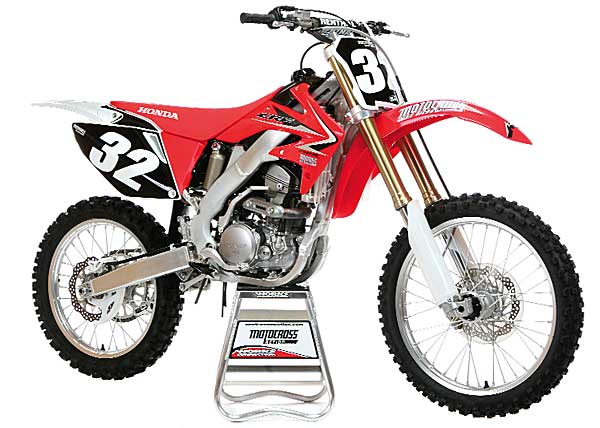
(1) Honda. Honda focused on improving power off the bottom and also increasing pull over the top. Their approach worked, because the CRF250 has an even stronger engine than it did in 2008. That’s not surprising, because we liked last year’s powerband also. The added torque and horsepower are icing on an already excellent cake. It has decent hit down low, pulls hard through the middle and has extra oomph into the top end. It’s the 2009 engine that covers the most ground.
(2) Kawasaki. MXA test riders love the KX250F powerband. It is an engine that is built for racing. Although not all that strong off the bottom, it makes up for it through the middle and top. For a racer, the Kawasaki’s powerband is perfectly situated. It doesn’t come anywhere close to making the most power, but it puts what power it has in the center of the pocket. Interestingly enough, for all of the changes that Kawasaki made to the KX250F, the engine profile mirrors the 2008 model.
(3) Yamaha. In an attempt to further strengthen low-to-mid power and throttle response, Yamaha’s engineers lengthened the head pipe by 60mm and shortened the muffler by 50mm. Every MXA test rider noticed improvements in the targeted areas. Unfortunately, it was not enough to get the ancient YZ250F engine to the top of the heap. The 2009 YZ250F needs more help across the top to run with the CRF250, KX250F and KTM 250SXF.
(4) KTM. Shoulda, coulda, woulda. Those are words that perfectly describe the 2008 KTM 250SXF’s anemic powerband. For 2009, KTM improved bottom-end power, but that step in the right direction was masked by the poor gearing combination that comes stock on the bike. Adding a tooth to the rear sprocket is a must-do for the 250SXF. Once geared properly, the high rpm powerband comes to life (if you hold it on long enough to take advantage of a powerband that peaks above 12,000.) The KTM is the king of top-end power.
(5) Suzuki. The RM-Z250 powerband is described by every MXA test rider with one word?”fun.” Yet, fun is not the optimum powerband for a hardcore racing machine. No other bike can touch the RM-Z250’s explosive response off the bottom, but once the rpm begins to climb, the Suzuki quickly gives up the ghost. Every test rider would like to see Suzuki broaden out the RM-Z250’s powerband.
HOW DO THEY RUN ON THE DYNO?
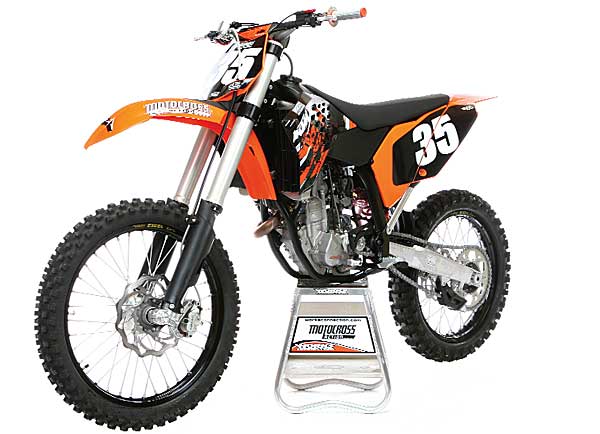
(1) KTM. If peak horsepower was all that mattered, the 2009 KTM 250SXF would win easily. KTM has long produced the most powerful engines, but most MXA test riders prefer powerbands that start lower in the curve and hit harder in the middle than the 2009 KTM. The 250SXF engine is almost nonexistent from 5000 rpm through 10,000 rpm, but then blows the doors off the competition from 10,800 to 13,200 rpm. The 250SXF produces 38.60 horsepower at peak, over 1-1/2 horses more than any other bike.
(2) Honda. From 8200 rpm to 11,300 rpm, the 2009 Honda CRF250 rules the roost. The breadth of the CRF250’s mid-and-up power goes a long way in characterizing the expansive power that the CRF250 exudes. It doesn’t produce the most peak horsepower, the most low end or the most top end, but it is the strongest engine through the meat of the powerband. The 2009 CRF250 topped out at 37.1 horsepower, second best in the class.
(3) Suzuki. The Suzuki starts off the bottom like gang-busters. It bursts to life, but, much like the YZ250F, the RM-Z250 engine hangs once it approaches the top end. It produces the best horsepower from 5200 to 6000 rpm, but then becomes soft in the middle. At 36.48 horsepower, the RM-Z250 produces the third most horsepower at peak.
(4) Yamaha. There is no way around the fact that Yamaha makes a solid engine. It is at its best from 6500 rpm to 8200 rpm (where the low end transitions into the midrange). After that, the YZ250F falls rather flat, which means that the bike needs to be short-shifted. The 2009 YZ250F reaches a more than respectable 36.41 horsepower, fourth in the class (but only 0.07 horsepower behind the third place RM-Z250).
(5) Kawasaki. This is not a great dyno bike, but thankfully it is better on the race track. The KX250F ran well from 6000 rpm to 10,000 rpm. It wasn’t the most potent engine at any point on the dyno curve, but it hung with the Yamaha YZ250F in the low-to-mid transition and clung to the CRF250 as it crossed over to the top end. The KX250F had a maximum horsepower of 35.4, which was the weakest in its class, but it was the best placed (which we rate higher than just numbers).
WHICH ONE HANDLES THE BEST?
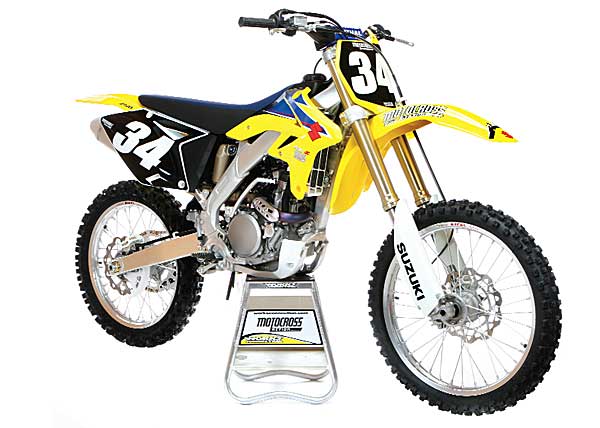
(1) Suzuki. Suzuki’s handling goals have long been centered around quickness, accuracy and precision. They have done a great job achieving their objectives. Unlike many previous Suzukis, which traded stability for cornering ability, the 2009 RM-Z250 has acceptable stability at speed. Every MXA test rider was enamored with the RM-Z250’s handling ability, making it the winner in every discussion of handling.
(2) Honda. The gap between the handling of the RM-Z250 and the CRF250 is quite large, although a lot of it is magnified by the softness of the Suzuki forks and the harshness of Honda’s Showa forks. Suspension aside, the Honda is a good second choice when it comes to the handling sweepstakes. After we lowered the oil height in the Showa forks, the CRF250 handled much better.
(3) KTM. The KTM, like the Honda CRF250, suffers from serious midstroke harshness. If the MXA test riders had ridden the KTM without working on the forks, they would have rated it dead last. Thankfully, with the oil height lowered the forks allowed the KTM to become much more stable and precise.
(4) Yamaha. There are bikes that don’t do anything really right, but don’t do anything really wrong, either. That defines the 2009 Yamaha YZ250F. Every MXA test rider agreed that the YZ250F handled okay. There were no frills or thrills to the chassis. In comparison, the 2009 YZ250F handles better than the 2008 model because the chassis feels more alive on the entrance to turns. All in all, though, it’s a milquetoast handler.
(5) Kawasaki. There is no doubt that Kawasaki’s engineers knew they had some handling issues in the past. How do we know? They made an effort to change in 2009. Changing the offset from 24.5mm to 23.5mm and making numerous chassis adjustments proves that they wanted to fix the KX250F’s tendency to stand up in the center of corners and push from the center-out. They had good intentions, but it didn’t work. We did everything to the 2009 KX250F that we did to the 2008 to fix the cranky cornering (i.e., 22mm offset triple clamps and Pro Circuit linkage).
WHICH 2009 BIKE HAS THE BEST FORKS?
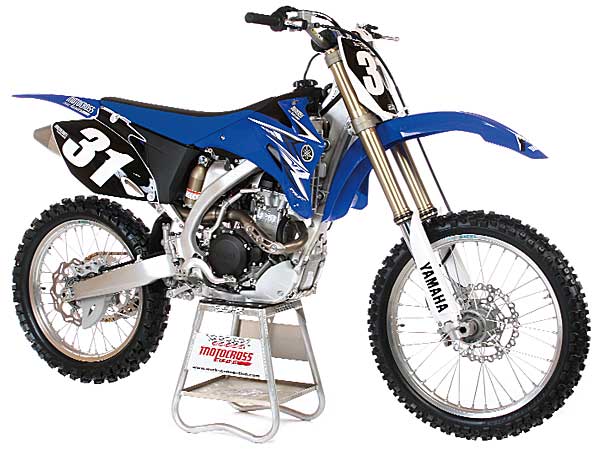
(1) Yamaha. Would it sound harsh if we said that Yamaha is the only company that seems to be trying in the fork department? The YZ250F’s Kayaba SSS (Speed Sensitive System) forks had us at “Hello.” The YZ250F uses stiff spring rates to accommodate Joe Racer, but the softer damping allows for a plush feel that’s forgiving and lets the forks use their full stroke. The YZ250F has the best forks in the class, period.
(2) Kawasaki. The KX250F gets second place because it didn’t make any setup mistakes. The KX250F Showa forks work well in most conditions, and the spring rate is correct for a wide range of riders. The KX250F forks weren’t as plush as the YZ250F’s SSS units, but they were in the ballpark.
(3) Honda. No one, from Beginner to Pro, will be satisfied with the stock CRF250 forks. They are harsh in the midstroke. Every bump or ripple in the track sends a painful jolt to the rider’s wrists. These forks were bad last year, and they are bad this year. Thankfully, by lowering the oil height by 10 to 15cc, the midstroke harshness can be greatly diminished. This is a simple fix that will not cost any extra money.
(4) KTM. We were pretty happy with the mods that KTM made to the 2009 450SXF forks, but the same magic did not apply to the 250SXF WP units. The 250SXF’s forks mirror Honda’s Showa forks in terms of midstroke harshness. KTM did give lip service to taking some of last year’s midstroke harshness out by lowering the stock oil height by 5cc. Unfortunately, they are still 15cc short of success. Draining the oil allows the WP USD forks to use their full travel.
(5) Suzuki. The RM-Z250 forks are sprung for a jockey. They are far too soft for a normal racer and barely work for a 150-pound Novice. Stiffer fork springs are required to keep the front end up through hard braking and over mid-to-large scale bumps. Faster or bigger riders might even look into jumping up two spring rates in the forks, because they are softer than butter under the Tucson sun.
WHICH 2009 BIKE HAS THE BEST SHOCK?
(1) Yamaha. Just as in our fork comparison, the YZ250F takes the cake in the shock category. Despite changing the shock linkage pivot locations, Yamaha still maintained the same linkage ratio (which is a good thing). The 5.3kg/mm spring rate works well for most riders’ size, weight and speed. The Kayaba SSS fork and shock combo is the best attribute of the 2009 YZ250F.
(2) Honda. There is a tight race for second in the shock category (well after Yamaha sewed up the crown). The CRF250 isn’t head-and-shoulders above the Kawasaki, but the stock settings are closer to what every MXA test rider preferred. We made minimal clicker adjustments, only going in on high-speed compression.
(3) Kawasaki. The Showa unit provides good actuation and bottoming resistance, but it took an entire turn in on high-speed compression to reach a good baseline setting. We discovered that the KX250F works best when the low-speed compression is turned in and the high-speed compression is used to adjust the ride height.
(4) Suzuki. Just like the forks, the RM-Z250 shock would greatly benefit from a stiffer spring. The stock 5.4 kg/mm spring is too soft for riders over 150 pounds and those with Novice to Pro level speed. That only leaves very skinny kids with minimal velocity.
(5) KTM. We didn’t like the KTM shock. It has the odd habit of working some of the time, not working some of the time, and scaring us the rest of the time. At its worst, it has a tendency to pack in consecutive bumps and step out unpredictably. These traits put the 250SXF in last place in the shock department.
WHICH BIKE HAS THE BEST STOCK JETTING?
(1) Suzuki. We had very few issues with the jetting on last year’s 2008 Suzuki RM-Z250, so it should come as no surprise that we were pleased with the stock spec on the ’09. Suzuki went with a smaller pilot jet, which helped liven up the throttle response. Our only troubles came when we added an aftermarket pipe. It threw the jetting off.
(2) Yamaha. Yamaha was very close to perfect on jetting, especially for sea-level Southern California tracks. There was a slight hesitation directly off idle, which was remedied by turning the fuel screw out a half a turn. We left everything else alone.
(3) Kawasaki. The KX250F jetting was too rich for most conditions found on this planet. We dropped the mainjet, raised the pilot jet and went in on the fuel screw to lean out the jetting. Otherwise, the KX250F has a tendency to feel rich off the bottom and under heavy acceleration.
(4) KTM. The 250SXF, like the YZ250F, had a slight bog off the bottom, only it was more pronounced. We figured that fine-tuning the fuel screw would eradicate the problem, but it didn’t. In the end, we turned the accelerator pump adjustment screw in until it made contact with the pump and then backed it out a quarter of a turn. This process isn’t easy, but it’s a must-do.
(5) Honda. No one should be surprised that the CRF250 finished last in the race for best jetting. The 40mm Keihin carb is too large for the 250 four-stroke engine. We would love to see Honda revert back to the 37mm unit from 2005. The CRF250 coughs, especially when landing off jumps. The fix required a different pilot jet, needle, fuel screw adjustment and also leak jet.
WHICH 2009 BIKE HAS THE BEST GEARING?
(1) Yamaha. The YZ250F didn’t need the addition of any extra teeth. We tried adding an extra tooth to the rear sprocket, but the gap between second and third gear became too close for comfort. Stick with the stock 13/49 gear combo and be happy.
(2) Honda. Like the YZ250F, the CRF250 didn’t need any gearing changes. Thankfully, due to the increased power down low, the 2009 CRF250 gearing works even better than it did last year.
(3) Kawasaki. Despite all of the changes made to the 2009 KX250F, none could help the engine handle the stock 13/48 gearing. The Kawasaki is geared too tall. Gearing the bike down a tooth in the rear will close the sizable gap between second and third gear.
(4) Suzuki. The RM-Z250’s gearing is manageable, but in order to really emphasize the low-to-mid power, we suggest adding an extra tooth to the rear. The different ratio allows the RM-Z250 to explode out of tight turns in second gear and approach fast turns in third gear.
(5) KTM. The 250SXF is geared too tall. The lack of low-end power begs for at least one extra tooth on the rear sprocket. Switching to a 49-tooth sprocket will greatly aid the powerband in maximizing output. On tighter tracks, a 50-tooth sprocket might even be necessary.
WHICH 2009 BIKE HAS THE BEST BRAKES?
(1) KTM. Comparatively speaking, the 250SXF’s front brake is as powerful as Chuck Norris in a fight against grade-schoolers. It is far and away the strongest front brake out of the Big Five, and the rear brake is also very strong. We would love to see the 250SXF front brake on every other bike, because it allowed test riders to go deeper into corners.
(2) Yamaha. The YZ250F has relatively strong no-nonsense brakes. Between the two, the rear is much better at stopping on a dime.
(3) Suzuki. The 2009 RM-Z250 has a very good front brake, which provides good feel. The downfall of the RM-Z250’s braking system is in the rear, where the brake lacks serious pucker power and is touchy to adjust.
(4) Kawasaki. Over the last few years, the KX250F hasn’t had strong brakes. Alas, the ’09 model has the same mediocre braking traits. By no means are the brakes bad, but they can’t even be in the same sentence as the KTM 250SXF brakes.
(5) Honda. The CRF250 has strong brakes, front and rear, but there is a major catch. With the stock front disc guard on, the brake system tends to overheat and fade. After we removed the guard (a tedious process of hacksawing the guard away from the molded-in axle spacer) the power of the front brake could last a whole moto.
WHICH 2009 BIKE HAS THE BEST STOCK TIRES?
(1) Yamaha. Yamaha worked with Bridgestone to spec their own front tire, labeled the 403A. The knobs are sharper and the tire itself has a flatter tread pattern to provide for a wider footprint. Every MXA test rider enjoyed the YZ250F-specific Bridgestone 403A front, along with the 404 rear.
(2) Kawasaki. The KX250F tire combination was trumped by the YZ250F. Kawasaki outfitted the KX250F with a Bridgestone 403/404 pairing, but the front doesn’t offer as much grip as the 403A.
(3) KTM. The Austrian bike also comes with Bridgestone rubber, but KTM opted for a very odd (and almost archaic) Bridgestone M59/M70 combo. These tires prefer soft-to-intermediate dirt and slide on hard pack.
(4) Honda. The handling on the CRF250 could be drastically improved by lowering the fork oil height, but gains could also be made by switching the stock Dunlop 742FA front tire. The 742FA works best in intermediate terrain, but slides uncontrollably on hard pack or in wet conditions.
(5) Suzuki. The RM-Z250 uses the same Dunlop 742FA/756 tire combo that the CRF250 does. So why is it rated behind the CRF250’s identical tires? Because the RM-Z250 turns so much sharper than the CRF250 that it puts a bigger load on the front tires. We switched the front tire for a 756 or 745 (depending on track conditions).
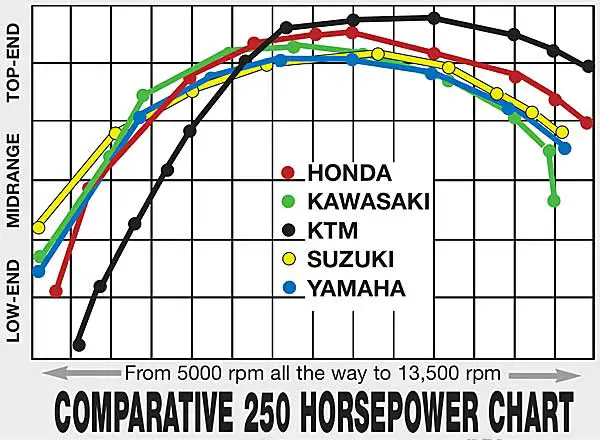
HOW WOULD THE MXA TEST CREW DESCRIBE EACH BIKE?
Kawasaki KX250F. The 2009 KX250F engine is bred for racing. It’s strong, fast and caters to Intermediate and Pro-level riders. The suspension works well, but the front end has a tendency to push from center-out in corners. The gearing is off base, but that can be fixed with a bigger rear sprocket. Kawasaki also switched to a ratchet-style gear system, but we still encountered shifting problems. Overall, the KX250F is a solid package, save for a few issues.
KTM 250SXF. The 250SXF could be such a sweet machine, if only the forks weren’t bone-jarringly harsh and the stock gearing wasn’t set up for the drag strip. We’re optimistic that KTM can do much better with only a few minor refinements. Decreasing the fork oil height, changing the accelerator pump screw and adding a tooth to the rear are the first orders of business.
Yamaha YZ250F. By now we may sound like a broken record when discussing the YZ250F, but this is an old bike gussied up to go to the prom. The engine is strong through the midrange, but it lacks the fun factor. The suspension is the best in its class, but the chassis is just average. The jetting is almost spot-on, and the gearing is correct. It’s a solid, no frills motorcycle for a solid no-frills racer.
Honda CRF250. Honda’s best work was with the powerband of the 2009 CRF250. It’s faster, torquier and blessed with more over-rev. The horrid jetting and harsh forks are downers. Luckily, the forks and jetting can be fixed without too much trauma. The CRF250 has the best all-around engine in the class and has decent handling.
Suzuki RM-Z250. The 2009 RM-Z250 is really the 2008 RM-Z250 with a few aesthetic changes. With that said, the Suzuki has the best power off the bottom, jetting that is spot-on and superb handling. The three flaws are a lack of top end power, tall gearing and suspension settings that are severely undersprung. It’s fun, but the suspension and power are too soft.
250F SHOOTOUT WINNER…
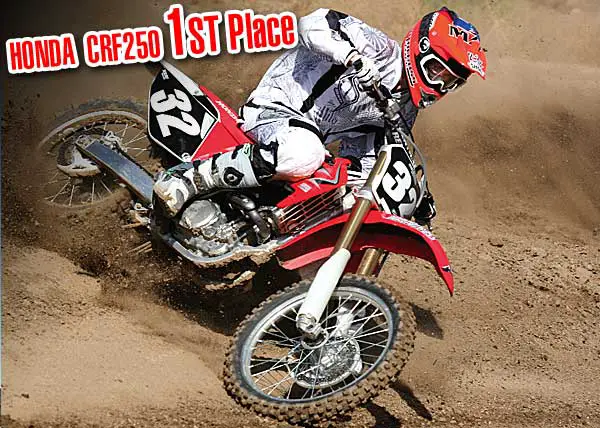
(1) Honda CRF250. Surprise! For the first year since its inception, the CRF250 has earned the number one spot in MXA’s 250 Four-Stroke Shootout. How did Honda receive the nod for 2009? The two most important traits of a 250F?the engine and handling?are very good on the CRF250. It’s not a perfect machine (the forks are harsh, the front tire is unpredictable and the jetting is off), but these problems can be easily fixed. The CRF250 was close to winning the crown last year, but thanks to this year’s powerband improvements, it made it to the top step.

(2) Kawasaki KX250F. Kawasaki went back to the drawing board for 2009 and made major changes to an already strong package. These advancements, while many, weren’t that noticeable on the track. Changing the triple clamp offset still yielded a push from center-out in corners, and adding weight to the crank didn’t seem to improve bottom-end performance. The 2009 KX250F is a great bike, but the handling, jetting and gearing need to be fixed.

(3) Yamaha YZ250F. The YZ250F has cemented itself as the third place finisher in MXA’s 250F shootout because it’s a solid package that doesn’t do anything extraordinarily well?save for the Kayaba SSS suspension. The YZ250F is a racer’s bike that has a decent engine and relatively good handling. The question remains as to whether Yamaha will release an all-new YZ250F engine in 2010. It needs it.
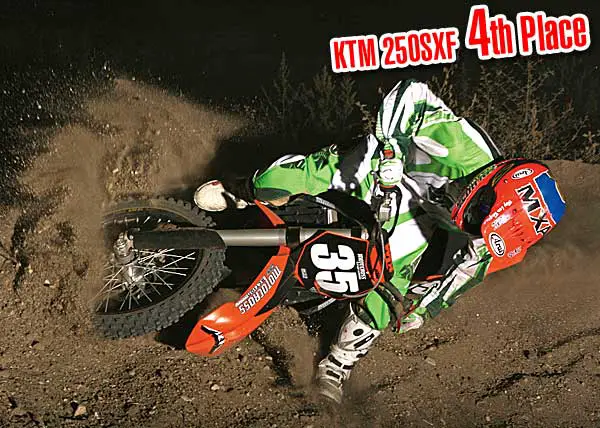
(4) KTM 250SXF. KTM has the pedigree for success, if your definition of success doesn’t count suspension, throttle response or gearing. Last year the 250SXF finished last in our shootout. KTM gave it the old college try with many small refinements, but they weren’t enough. Still, the 250SXF can be tweaked to become a much better bike.
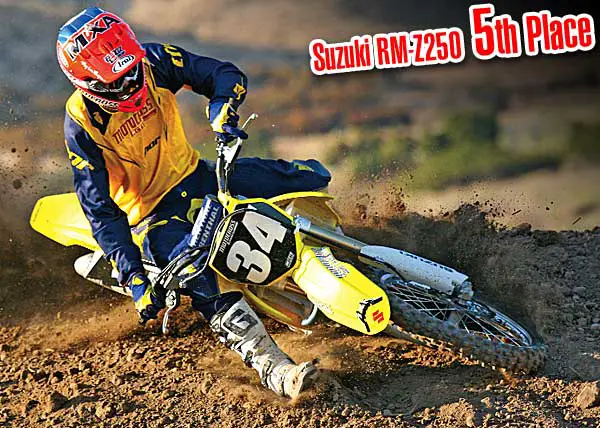
(5) Suzuki RM-Z250. Not a single MXA test rider wanted to rate the RM-Z250 in last place. They always said, “It’s so much fun to ride. It deserves a higher ranking.” And then they ranked it fifth. Why? The suspension is undersprung and the engine lacks top end power. Suzuki, by their own design, has pigeonholed the RM-Z250 into being a great bike for mini bike riders making the step up to big bikes.
MXA’S RECOMMENDED 2009 JETTING SETTINGS
YAMAHA YZ250F
Main: 178
Pilot: 42
Needle: NHKR
Clip: Fourth from top (4th stock)
Fuel screw: 2-1/2 turns out (2 stock)
Leak jet: 70
HONDA CRF250
Main: 185
Pilot: 45 (42 stock)
Needle: NNWT (NNSU stock)
Clip: Third from top
Fuel screw: 1-1/4 (2-1/4 stock)
Leak jet: 60 (70 stock)
KAWASAKI KX250F
Main: 180 (182 stock)
Pilot: 42 (40 stock)
Needle: NHJT
Leak jet: 55
Clip: Fourth from top
Fuel screw: Two turns out (2-1/8 stock)
Leak jet: 55
SUZUKI RM-Z250
Main Jet: 162
Pilot Jet: 42
Needle: NLCT-3
Clip: Third from top
Fuel screw: 1-1/2 turns out
Leak Jet: 40
KTM 250SXF
Main: 175
Pilot: 40
Needle: OBEKP
Clip position: Fourth from top
Fuel screw: 1-1/4 turns (1 stock)
Leak jet: 50
MXA’S RECOMMENDED 2009 FORK SETTINGS
YAMAHA YZ250F
Spring rate: 0.45 kg/mm
Oil quantity: 521cc
Compression: Eight clicks out (nine stock)
Rebound: Nine clicks out (ten stock)
Fork leg height: 5mm up
HONDA CRF250
Spring rate: 0.46 kg/mm
Oil quantity: 398cc (408cc)
Compression: 11 clicks out (seven stock)
Rebound: Nine clicks out
HPSD: Seven clicks out
KAWASAKI KX250F
Spring rate: 0.44 kg/mm
Oil height: 306 cc
Compression: Nine clicks out
Rebound: Nine clicks out (11 out)
Fork leg height: 5mm up
SUZUKI RM-Z250
Spring rate: 0.46 kg/mm (0.44 stock)
Oil height: 370cc
Compression: Ten clicks out
Rebound: 12 Clicks out
Fork leg height: 2mm up
KTM 250SXF
Spring rate: 0.46 kg/mm
Oil height: 370cc (385cc stock)
Compression: 16 clicks out (15 stock)
Rebound: 20 clicks out (19 stock)
Fork leg height: 5mm up
MXA’S RECOMMENDED 2009 SHOCK SETTINGS
YAMAHA YZ250F
Spring rate: 5.3 kg/mm
Race sag: 100mm
High-compression: 1-3/4 turns out (1-1/2 stock)
Low-compression: Nine clicks out
Rebound: Eight clicks out
HONDA CRF250
Spring rate: 5.3 kg/mm
Race sag: 102mm
High-compression: Two turns out (2-1/8 stock)
Low-compression: 16 clicks out (11 stock)
Rebound: Six clicks out (11 stock)
KAWASAKI KX250F
Spring rate: 5.4 kg/mm
Race sag: 100mm
High-compression: 1-1/4 turns out (2-1/4 stock)
Low-compression: Nine clicks out (12 stock)
Rebound: Ten clicks out (12 stock)
SUZUKI RM-Z250
Spring rate: 5.6 kg/mm (5.4 stock)
Race sag: 100mm
High-compression: Two turns out
Low-compression: Eight clicks out
Rebound: Eight clicks out
KTM 250SXF
Spring rate: 6.9 kg/mm
Race sag: 110mm
High-compression: 1-3/4 turns out (one stock)
Low-compression: 12 clicks out (15 stock)
Rebound: 19 clicks out (22 stock)






Comments are closed.